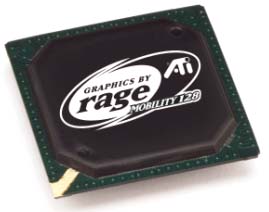 Specifications
Specifications
The Rage Mobility 128 specs are somewhat interesting to look at and told us quite a bit before we even received our evaluation sample. The most important thing to remember is that this is still a mobile solution, so the specs are not up to par with the latest and greatest on the desktop side of things. What the Mobility 128 is, however, is the first chip that brings reasonable 3D performance to the mobile space. It does so with an all-in-one package that's pin compatible with other members of the ATI Rage Mobility family, allowing great flexibility for OEM's that can produce notebooks for different market segments with a single motherboard design.
The Mobility 128 is largely based on the Rage 128 Pro core that is found in the Rage Fury Pro and Rage Fury MAXX, but with a number of modifications and additions to make it suitable for the mobile environment. The Rage 128 Pro core provides the 2D engine, 3D engine, hardware DVD decoding, and a TMDS transmitter. The TMDS transmitter provides support for digital flat panels in the desktop Rage 128 Pro through a DVI interface and the same is true for the notebook version, although OEM's will have to actually implement it in their designs.

The Mobility 128 starts by adding dedicated hardware to provide ratiometric expansion on digital flat panels, which we'll talk about in detail later. A LVDS transmitter, which is necessary for the digital interface to the built-in LCD of the notebook, is next. By integrating the LVDS transmitter on chip, EMI is significantly reduced. Throw in support for spread spectrum and EMI is reduced even further without any additional weight or space. EMI is a major issue in notebook design and normally space is dedicated to additional shields to reduce it. Most mobile graphics solutions that are being released today would probably also feature an integrated LVDS transmitter.
For TV-out support, a 10-bit TV encoder is thrown in the package as well. AES power management provides dynamic gate level power management, allowing individual parts of the chip to power down when they're not in use, which leads to improved battery life.
The memory configuration of the Mobility 128 is where we start to see differences that affect performance. An all new memory controller and 8MB of SGRAM are also put in the chip package. It should be noted that this memory is not on-die, but rather simply in the same package as the graphics core in order to save PCB space - something that is crucial in notebook designs. The potential performance issues come from the fact that the interface to the internal memory is only 64-bit, which could cause a significant performance drop compared to the full 128-bit interface of the desktop part. This is similar to the performance loss we saw in the TNT2 M64 when compared to the original TNT2. Fortunately, the Mobility 128 also supports an external 8MB memory upgrade that boosts the memory interface to 128-bit, which should hopefully bring it back up to par with the desktop Rage 128 Pro.
The next performance hurdle stems from the fact that notebooks are by their nature extremely cramped machines with little space or power for cooling devices. As such, the clock speed of the Mobility 128 has been toned down from the desktop Rage 128 Pro. Instead of a 125/143 MHz core/memory clock, we get a 105/105 MHz configuration. With the ability to render two pixels per clock, that still results in a fillrate of 210 Mpixels/s, which is far greater than any notebook part on the market now and more than some that are still on the horizon.
Now 210 Mpixels/s doesn't sound like a whole lot with all the talk of gigapixel performance in the near future, but remember that the NVIDIA RIVA TNT was released about one and a half years ago and only offered 180 Mpixels/s. Further, the retail version of the Rage Fury, which featured the original Rage 128 chip, was released just over a year ago and featured a nearly identical clock speed. Then consider the fact that the the next closest competitor in the mobile market is the Mobile Savage from S3, which promises "just" 125 Mpixels/s and the Mobility 128 sounds better and better all the time.
All this is built on the same 0.25 micron process that ATI has used since the original Rage 128 was released. Ideally, a die shrink to 0.18 micron would allow for a higher clock speed, lower power consumption, and possibly more memory to be included on chip. The inclusion of embedded DRAM with a wider bus, perhaps 256-bit, could greatly enhance performance. Unfortunately, we've heard nothing from ATI as to the possibility of this in the future.










0 Comments
View All Comments